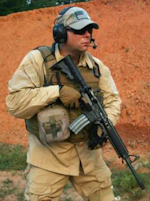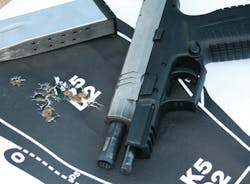The “eXtreme Duty” pistol, or XD, was first introduced in the most popular L.E. / self-defense calibers; .40 S&W and 9mm. Pistols in .357 SIG, .45 ACP, and .45 GAP were soon to follow. Naturally, we’ve seen the obligatory upsizing and downsizing of the XD as “tactical” and compact models were introduced.
A number of factors have worked in the XD’s favor. The most important of all from a consumer standpoint is price. XD pistols are priced at or below that of other comparable models. This aspect cannot be discounted as when all else is equal, the American gun buyer will favor price.
Not just another plastic gun knock-off, the XD boasted a number of attractive features including an ambidextrous magazine release, well designed grip safety, and excellent ergonomics. The pistol rides high in the hand and “points” naturally.
As with most modern duty quality pistols, the XD includes an internal, striker-driven firing mechanism combined with a positive, trigger safety. The loaded chamber and cocked striker indicators can be both seen and felt. The polymer frame includes an accessory rail, use it or don’t every modern pistol has one. Also, as you would expect, the pistol disassembles easily without tools.
Following handgun evolution, the XD transformed into the XD(M) a couple of years back. The “M” stands for Modular. New pistols have interchangeable backstraps in small, medium and large. More aptly they are thin, medium, and thick. The grip design was updated to provide a more secure hold on the pistol. Sticking to the modern handgun formula, the 9mm and .40 version of the XD(M) were introduced first. American gun buyers being who they are naturally took a look at the upgraded XD pistols and said “That’s nice. When are you going to come out with one in .45?”
XD(M) .45 ACP
It’s not really a secret that in order to be a serious player in the American handgun business you must catalog at least one .45 ACP pistol. I have no intention of arguing the pros and cons of this, it is simply reality. The new XD(M) chambering the beloved .45 ACP cartridge combines two things that many American shooters love; price and capacity. Magazine capacity for the .45 ACP version is 13 plus 1. When I sat down to pen this review I did some online research and found that the average gun shop price was well below $800. The median price was closer to $699.
As with all the XD(M) pistols, the .45 version is not just a gun, but an entire firearms kit. Inside a very nice padded hard case you will find a pistol, three stainless magazines, a polymer holster and twin-mag pouch, three interchangeable backstraps, a gun lock and magazine loading tool.
Getting to some specifics, the .45 ACP XD(M) weighs only 31 ounces empty. The hammer forged barrel is 4.5 inches long and has a fully supported and polished feed ramp. All .45 ACP barrels are Match grade. A forged steel slide sits atop a polymer frame. Black Melonite or Silver stainless steel slides are available. Top to bottom the pistol’s height is 5.75 inches. The manufacturer’s spec weight for the trigger is 5.5 to 7.5 pounds. Springfield now calls their XD trigger/action the “Ultra Safety Assurance” or “USA” trigger.
Sight channels are cut fore and aft on the pistol. The pistol I had to test included fixed sights in the three white-dot variety. Tritium® night sights are available from the factory or the shooter can install a number of aftermarket variations.
Range Time
In order to test the appetite of this autoloading pistol I took several .45 ACP loads of varied weights and manufacture to the range to test. Looks are great, but function in king and I wanted to test many type of ammunition. Along for the field trials was ammo from Black Hills, CCI, CorBon, Federal, and Wolf “Gold”. It has been many years since I worked with an XD pistol of any kind so I intended to get out on the range several times to really give me and the pistol a work out.
While it is important to ensure that your defensive/controlled expansion rounds will cycle and function in your pistol, that kind of ammunition is expensive. Trigger time for training is a lot easier on the wallet with the bulk boxes of FMJ ammo from various manufacturers. Before beginning the range portion of this piece I picked up a 250 count box of American Eagle .45 ACP from Federal. This is quality ammunition to be sure, but it was made for training, not duty or home defense.
On the first afternoon at the range I would be accompanied by my oldest son, Jarrad. Jarrad would help with the pistol’s break in and shoot some of the action shots as my assistant photographer. You’ve heard the term “sweating for your craft”? Well we were sweating that day as the mercury pushed into the high nineties and the barometer showed high humidity.
As it had been a while since I’d handled an XD pistol I wanted to reacquaint myself with the controls and unique aspects of the gun. Specifically, I wanted to get used to the XD’s trigger. This striker fired system has a relatively long reset when compared to others in its class. I was immediately impressed by two aspects of the pistol. First, for a .45 ACP the grip dimensions are comfortable and fit the hand well. My second impression was that the sights were right on from the factory. Head shots on a Birchwood Casey silhouette target were simply enough at ten and fifteen yards.
Jarrad and I ran somewhere in the neighborhood of one hundred and fifty rounds through the pistol on our first outing. All three magazines were loaded to capacity. The supplied loading tool proved invaluable. It helps you get the 12th and 13th rounds into the magazine without killing your thumbs. All five loads were mixed in to test the pistols eating habits. From the fast moving +P load from CorBon to the slow and heavy 230 grain FMJ’s from Federal and CCI, all the ammunition fed and cycled without issue.
Range session number two would begin with a slower pace. Chronographing chores were completed on my Shooting Chrony F1. Step two would be to post several targets downrange at 25 yards. With my arms resting on a rolled up range mat I set about the slow, deliberate testing. I was definitely happy with the results. Please refer to included table for complete details for each load.
The last portion of the test would include presentation from the holster, reloads, footwork drills etc. I donned the included holster and dual magazine pouch and loaded the magazines to capacity with Am. Eagle and CCI FMJ ammunition.
I worked both with and without gloves, fired single and weak handed. Targets were engaged from a seated position (folding chair), from my back, kneeling and prone. I moved forward, backward and laterally. By the time I completed my training session over two hundred pieces of once-fired brass were strewn across the range. The slide was too hot to touch with bare hands and I was convinced beyond a doubt that the new XD(M) .45 ACP pistol was a solid performer.
Parting Thoughts
As with all handguns each one has its own unique features and characteristics. To truly master and appreciate a pistol you need to spend some quality time (read trigger time) with it. This is particularly true when learning the trigger on a new gun.
Regarding the .45 ACP XD(M) I believe the kit is a great value and should certainly give the owner reliable service. Though functional, for my money I can definitely do without the 3 White Dot sights. First of all, if you begin with a clean, out of the box pistol all the white dots will be bright. The rear sight having double the white paint will draw your focus to it as it is brightly colored and closest to your eyes. A quick moment of adjustment and you are now focusing on your front sight. No problem? Perhaps not, think about this.
After a magazine or two you will notice that the front portion of the slide/muzzle area is a bit dirty. That’s where the burning propellant gas escapes. Guess what? Your front sight now has a light coat of carbon and the white dot is now dimmer that the clean rear sight. This makes finding your front sight and focusing on it quickly, versus the clean rear sight, even more difficult. How about we start with a bright, easy to pick up front sight and leave the rear sights dark?
The same issue occurs with 3 Dot Tritium or 3 Dot Fiber optic sights. There is twice as much light producing/gathering material in the rear as the front and the front sight invariably will get dimmer the more you shoot. When it comes to shooting handguns, particularly for personal defense, the front sight is King and should be your number one focal point. The rear sight in nice to have but of secondary import.
All in all, I was pleased with the pistol’s performance. Reliability was unquestionable and accuracy was as good as you could ask for from pistol of this kind.

Paul Markel
Mr. Markel is a former United States Marine, Police Officer, and has worked as a professional bodyguard both in the U.S. and overseas. A Subject Matter Expert on Small Arms and Tactics, Markel has provided instruction to law enforcement and U.S. Military troops.
As a recognized author and writer, Paul has penned several hundred articles published in numerous professional journals and trade periodicals. Topics include firearms training, use of force, marksmanship, less-than-lethal force options, product reviews and evaluations, emergency medical care, and much more. Sought after as a public speaker, Mr. Markel is at home in front of an audience large or small.
Follow Mr. Markel's instructional show: http://www.studentofthegun.com



